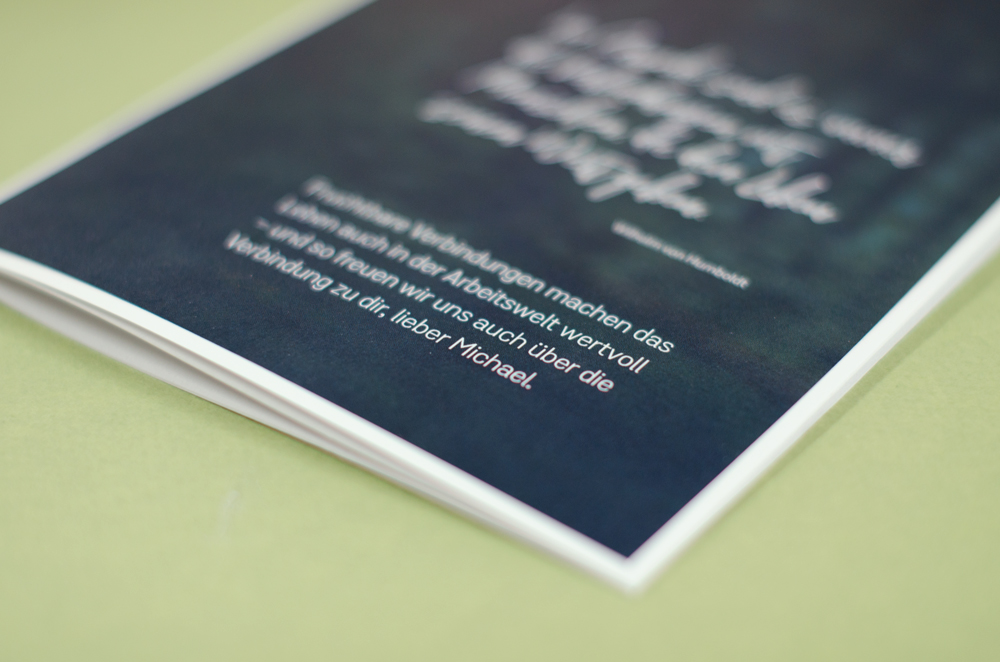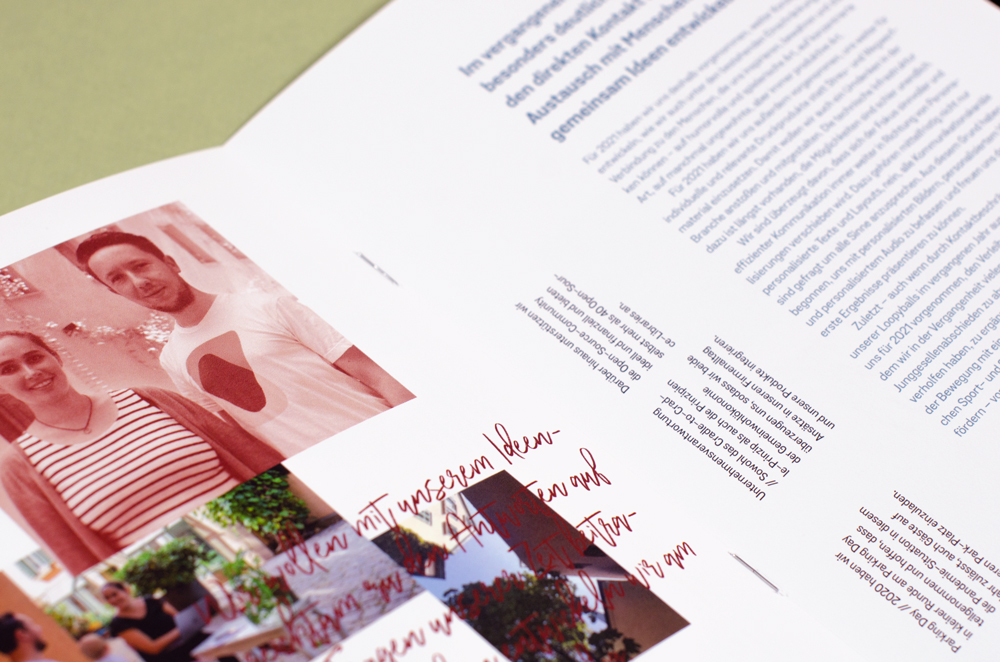Individualized brochures for the turn of the year 2020/2021
By Deborah Köngeter | Posted on 12. 2. 2021 | Updated on 22. 9. 2023
It is important to us to have very personal contact with the people we work with. That's why we have always associated our cards at the turn of the year with a review of the past year and an outlook on our goals for the coming one.
The logical progression of our always very personal New Year's greeting is — what could be more obvious? — the creation of individualized layouts using our own software. That's why we programmed an application to create the layouts, with which we were able to automatically generate around 200 individual brochures for our partners, customers and employees.
Strong customization always walks a fine line because people react differently to reading their personal information. Some people feel positively valued by an individual approach, while others perceive the individualization due to the data used as an invasion of their privacy. For this reason, we have included a reference to this article on the back of the brochures. It makes transparent how we have processed which data, thereby creating trust and awareness for the responsible use of personal and personal data.
Basics
Our individual printed matter does not require artificial intelligence, as is sometimes assumed. Our layouts are based on well-structured data sets and clearly defined design rules that were defined in advance by a designer and translated into code by a programmer. We are following our principle: good design does not need artificial intelligence, it needs human intelligence. This allows recurring design tasks to be carried out automatically.
Our New Year brochure application was written in PHP and uses, among other things, our IDML creator. This means that a copy was created for each recipient, in this case an IDML document that was converted into a PDF, then sent to the printer and produced digitally.
The application compiles content information from data sets together with design principles.
Dataset contents
Individualizations must always be handled carefully. They must comply with data protection regulations and should not disturb or unsettle the recipient. That's why we only use personal information if it offers added value. What's more: individualization only has the right to exist if it makes sense.
In the New Year's card, for example, individualization allows text variants — depending on the type of address — formal or informal —, supplemented by the use of first and last names and, if necessary, nicknames as well as the inclusion of places or company names. We don't solve this by filling placeholders in pre-created layouts, but rather by generating a separate complete file for each person and printing it digitally.
However, individualizations become valuable not only through the use of existing information, but also through the processing of this into new information. Such processing can be found, for example, in the text of the penultimate page. Here we combined the recipient's address with ours to calculate a village or town in the middle of the route. The text then suggests meeting there for coffee or tea. For this we used the Google API. This shows the character of our individualizations and how we deal with information: not in a blatant way, but with particular benefit.
Layout basics
The design adapts the corporate design of WirbelWild, the common umbrella of our business areas. As usual, we did not use placeholder logic for customization and filled an existing layout, but rather created complete layout documents with our software, in this case one for each recipient.
Grid
The design is based, among other things, on a grid. It allows
- the definition of areas that can be filled with defined information (e.g. the type area),
- as well as those that must be kept free of them (e.g. bridges),
- the placement of fixed elements (e.g. the quote on the title page) and
- the definition of design rules, for example for the placement options for the images in the collages.
Individualization of the text
Speech
We use a formal or informal speech, which is always supplemented with Mr/Mrs in the address. In addition, we have stored common nicknames that are used when addressing people by name in the text.
Location
We use the location of our office and the address of the recipients. Both are included in the text and in the address. In addition, we use the Google API to find a location that is as close as possible to the middle between the first two. If both locations are identical or there is no location in the middle of the route, a variant of the sentence is applied.
More text variants
In addition to the address and location, company names are integrated into the text where available.
Automation
Addition of the image material
The majority of the collages consist of own photos. To meaningfully supplement our image material, we use additional images via the API of the photo platform Flickr. Based on the image properties, our application checks whether there are photos of the recipient's location on Flickr. For each location we have access to a selection of images that the application can also integrate. This means that people who work in the same company and at the same location can receive collages with different photo material.
Collages
And what happens if you just leave everything to chance? For our collages, which show situations from our everyday office life over the past year — before and during the pandemic — we defined as little as possible. While the right-hand pages of the brochure contain a clearly defined flow layout, we worked exactly the opposite on the left-hand pages. Here we gave our software free rein and let it create collages as it saw fit. A variable number of text and image elements in different sizes were included. The order varies.
- The position and order of the elements is left to chance, but the position depends on the design grid.
- Elements must not extend into the bleed area.
- The degree to which two or more images can be superimposed is limited.
- The handwriting is always at the top level.
These types of collages are sometimes referred to as evolving layouts.
We did not use image recognition, which we could use for further design specifications. This resulted in 200 completely different variants of the collages.
Envelope
The envelope contains the logo of the respective business area with which the recipient is involved. In addition, the sender address is also individualized with the respective business area. The necessary individualization with the address of the recipient is hardly worth mentioning.
As with the brochures, the covers did not use placeholders. The application transferred the elements entirely into layout files and exported print-ready PDF files. The poem, which is the same on all covers, was also not pre-produced. Using only one printing process within the product also has the advantage that the color reproduction, which can vary with different processes, is the same.
Manufacturing
This year we published our New Year's greeting in the style of a small brochure. It consists of 8 pages in DIN A5 portrait format. It was printed by abcdruck with an HP Indigo on 135g/sqm Metapaper Extra RoughCold White. The envelope is made of the same paper. Only the grammage differs.
Are you interested in customizations of this kind?


